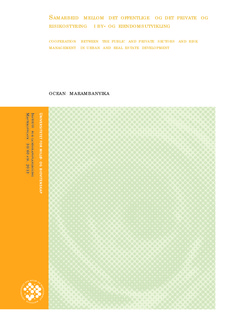| dc.description.abstract | Målet med denne oppgaven er å analysere samarbeidet mellom offentlige myndigheter og private aktører i by- og eiendomsutvikling. Spesifikt er ønsket å studere hvorfor det private og det offentlige velger å samarbeide i by- og eiendomsutviklingsprosjekter. Det er også et hoved objektiv å studere om risiko reduksjon driver det private og det offentlige til å samarbeide i by- og eiendomsutviklingsprosjekter. To forskningsspørsmål skal besvares i forbindelse med dette målet. Spørsmål en er: hvorfor velger det offentlige og det private å samarbeide i by- og eiendomsutviklingsprosjekter? Spørsmål to er: Er risiko reduksjon en motivasjon for både det private og det offentlige når det velger å inngå i privat offentlig samarbeid i by- og eiendomsutviklingsprosjekter? I denne oppgaven er betegnelsen offentlige myndigheter mest brukt til å referere til kommuner. Betegnelsen private aktører er mest brukt til å referere til eiendomsutvikler. By- og eiendomsutvikling inkluderer utbygging av større bolig- og industri prosjekter i byer. Det offentliges beslutningstaking i forbindelse med å samarbeide med det private er påvirket av lover, regler, markedet, kostnader, tid, risiko, politiske mål og mye mer. Det privates beslutninger er påvirket av økonomiske hensyn, markedet, kommunens reguleringsmakt, lover, risiko, kostander, tid, profitt, relasjonsbygging, renomme og mye mer. I denne avhandlingen skal disse faktorer brukes til å analysere hvordan faktorene påvirker valg om å inngå i samarbeidet.
En case studie av samarbeidet mellom Bergen Kommune og en privat aktør, Bergen og Omegn Boligbyggelag (BOB) er brukt til å vise et praktisk eksempel på samarbeidet mellom det offentlige og det private. Eksemplet hjelper også å forstå hvorfor det private og det offentlige velger å samarbeide. Gjennom case studien kan man også se at beslutninger knyttet til risiko redusering spiller en enorm rolle i samarbeidet mellom offentlige myndigheter og private utbyggere. The main purpose of this study is to analyze the cooperation between public authorities and
private developers in urban and real estate development. Specifically the intention of the
study is to understand why the public and private sectors chose to cooperate in urban and real
and estate development projects. It is also the main objective of the research to study if risk
affects the public and private actor’s preferences of cooperating in urban and real estate
development. Two research questions will assist in achieving these research aims. The first
research question is: Why do public and private sector actors chose to cooperate in urban and
real estate development projects? The second research question is: Does the motivation to
reduce risk drive the public and private sectors to cooperate in urban and real estate
development projects? In this project the term “the public” authorities will be used to refer to
local city councils or municipalities. The term “the private” actors will be used to refer mainly
to real estate developers.
Urban and real estate development involves construction of big housing and industrial
projects. The public authority’s decision making in connection with whether or not to
cooperate with the private sector is influenced by many factors. Some of the factors include:
laws, regulations, markets, costs, time, risk, political goals and so forth. On the other hand the
private sector`s decisions on whether or not to cooperate with public authorities is influenced
by factors which include economic decisions, markets, the public authorities’ power to
regulate, risk, laws, costs, time, profits, network building, reputation and so forth. These and
other factors will form the premise upon which the research aims of this thesis will be
advanced.
A case study from Norway`s Bergen city council will be used to illustrate how the private and
public sectors cooperate in urban and real estate development. This case study will show how
Bergen city council and a private actor called Bergen and Omegn housing corporative are
cooperating in urban transformation of a degraded area of Bergen city. Unlike in countries
like the UK, in Norway housing cooperatives are viewed on the same terms as private
developers. This example helps in understanding why the private and public actors chose to
cooperate in urban and real estate development projects. Through this case study can one gain
a deeper understanding of how the motive to reduce risk drives the private and the public
sectors into cooperating. | no_NO |
